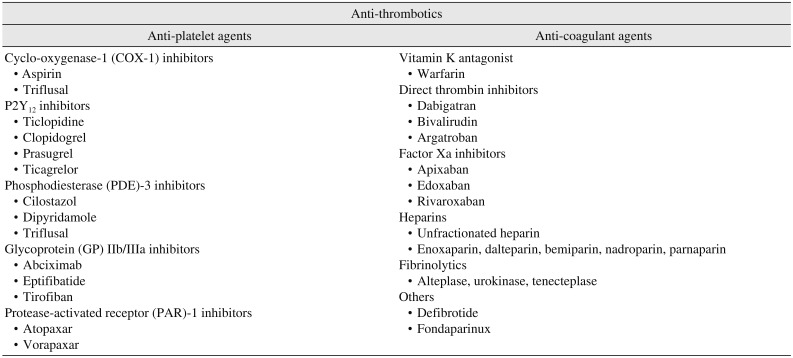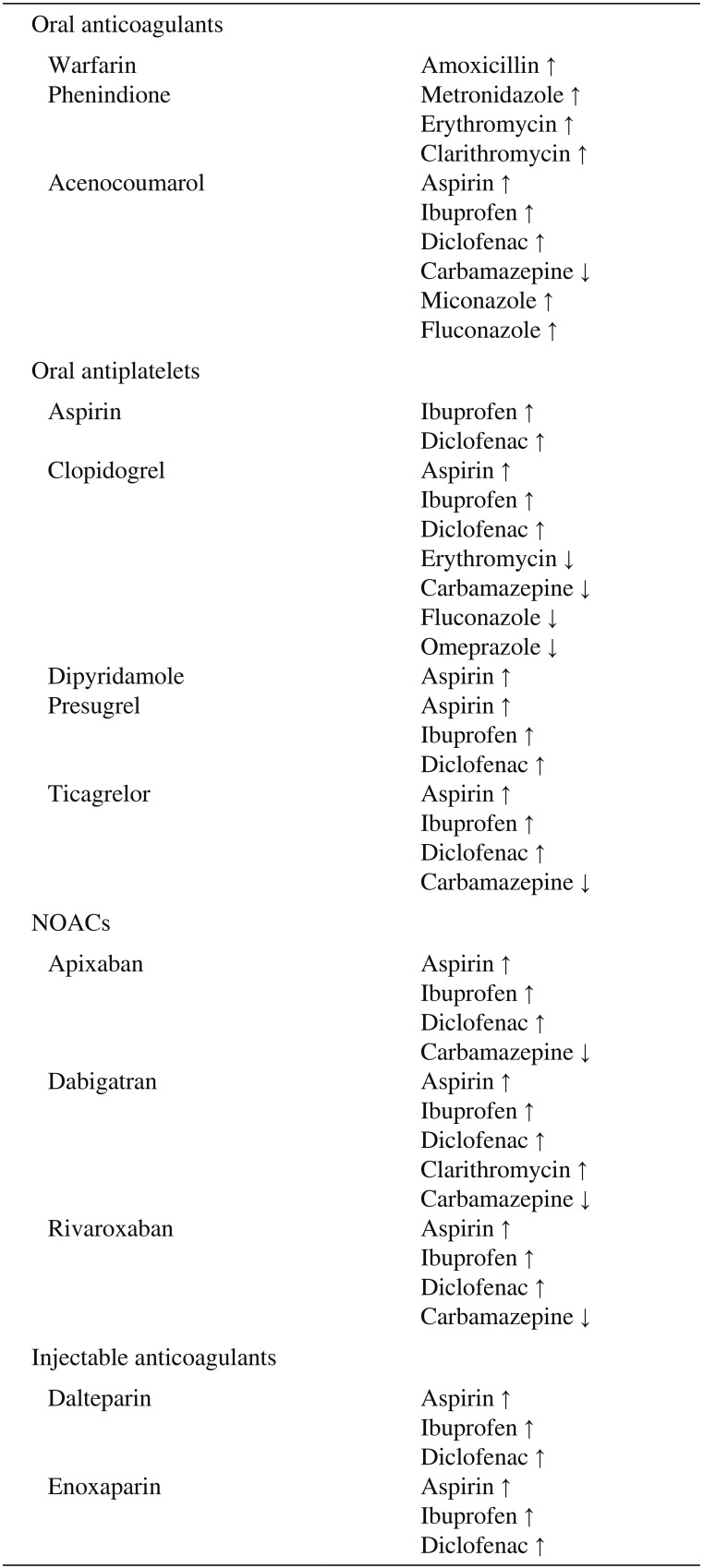1. Vahanian A, Alfieri O, Andreotti F, Antunes MJ, Barón-Esquivias G, Baumgartner H, et al. Guidelines on the management of valvular heart disease (version 2012): the joint task force on the management of valvular heart disease of the European society of cardiology (ESC) and the European association for cardio-thoracic surgery (EACTS). Eur Heart J. 2012; 33:2451–2496. PMID:
22922415.
2. Camm AJ, Kirchhof P, Lip GY, Schotten U, Savelieva I, Ernst S, et al. Guidelines for the management of atrial fibrillation: the task force for the management of atrial fibrillation of the European society of cardiology (ESC). Europace. 2010; 12:1360–1420. PMID:
20876603.
3. Wolberg AS, Aleman MM, Leiderman K, Machlus KR. Procoagulant activity in hemostasis and thrombosis: Virchow's triad revisited. Anesth Analg. 2012; 114:275–285. PMID:
22104070.
5. Coleman RA, Kennedy I, Humphrey PPA, Bunce K, Lumley P. Prostanoids and their receptor. In : Emmett JC, editor. Comprehensive medicinal chemistry: membranes and receptors. Oxford: Pergamon Press;1990. p. 643–714.
6. Levine GN, Bates ER, Blankenship JC, Bailey SR, Bittl JA, Cercek B, et al. 2011 ACCF/AHA/SCAI Guideline for percutaneous coronary intervention. A report of the American college of cardiology foundation/American heart association task force on practice guidelines and the society for cardiovascular angiography and interventions. J Am Coll Cardiol. 2011; 58:e44–e122. PMID:
22070834.
7. Lange RA, Hillis LD. The duel between dual antiplatelet therapies. N Engl J Med. 2013; 368:1356–1357. PMID:
23473370.

8. Biondi-Zoccai GG, Lotrionte M, Agostoni P, Abbate A, Fusaro M, Burzotta F, et al. A systematic review and meta-analysis on the hazards of discontinuing or not adhering to aspirin among 50,279 patients at risk for coronary artery disease. Eur Heart J. 2006; 27:2667–2674. PMID:
17053008.
9. Oscarsson A, Gupta A, Fredrikson M, Järhult J, Nyström M, Pettersson E, et al. To continue or discontinue aspirin in the perioperative period: a randomized, controlled clinical trial. Br J Anaesth. 2010; 104:305–312. PMID:
20150346.

10. Dorsam RT, Kunapuli SP. Central role of the P2Y12 receptor in platelet activation. J Clin Invest. 2004; 113:340–345. PMID:
14755328.

11. Cattaneo M. Response variability to clopidogrel: is tailored treatment, based on laboratory testing, the right solution? J Thromb Haemost. 2012; 10:327–336. PMID:
22221409.

12. de Morais SM, Wilkinson GR, Blaisdell J, Nakamura K, Meyer UA, Goldstein JA. The major genetic defect responsible for the polymorphism of S-mephenytoin metabolism in humans. J Biol Chem. 1994; 269:15419–15422. PMID:
8195181.

13. Mega JL, Close SL, Wiviott SD, Shen L, Hockett RD, Brandt JT, et al. Cytochrome P450 genetic polymorphisms and the response to prasugrel: relationship to pharmacokinetic, pharmacodynamic, and clinical outcomes. Circulation. 2009; 119:2553–2560. PMID:
19414633.
14. Birkeland K, Parra D, Rosenstein R. Antiplatelet therapy in acute coronary syndromes: focus on ticagrelor. J Blood Med. 2010; 1:197–219. PMID:
22282698.
15. Davì G, Patrono C. Platelet activation and atherothrombosis. New Engl J Med. 2007; 357:2482–2494. PMID:
18077812.

16. Furie B, Furie BC. Mechanisms of thrombus formation. New Engl J Med. 2008; 359:938–949. PMID:
18753650.

17. de Souza Brito F, Tricoci P. Novel anti-platelet agents: focus on thrombin receptor antagonists. J Cardiovasc Transl Res. 2013; 6:415–424. PMID:
23435863.

24. Pollack CV Jr, Reilly PA, Eikelboom J, Glund S, Verhamme P, Bernstein RA, et al. Idarucizumab for dabigatran reversal. N Engl J Med. 2015; 373:511–520. PMID:
26095746.

25. Blommel ML, Blommel AL. Dabigatran etexilate: a novel oral direct thrombin inhibitor. Am J Health Syst Pharm. 2011; 68:1506–1519. PMID:
21817082.

26. Eikelboom JW, Connolly SJ, Brueckmann M, Granger CB, Kappetein AP, Mack MJ, et al. Dabigatran versus warfarin in patients with mechanical heart valves. N Engl J Med. 2013; 369:1206–1214. PMID:
23991661.

27. Brown DG, Wilkerson EC, Love WE. A review of traditional and novel oral anticoagulant and antiplatelet therapy for dermatologists and dermatologic surgeons. J Am Acad Dermatol. 2015; 72:524–534. PMID:
25486915.

28. Armstrong MJ, Gronseth G, Anderson DC, Biller J, Cucchiara B, Dafer R, et al. Summary of evidence-based guideline: periprocedural management of antithrombotic medications in patients with ischemic cerebrovascular disease: report of the guideline development subcommittee of the American academy of neurology. Neurology. 2013; 80:2065–2069. PMID:
23713086.

29. Hsueh WD, Hwang PH, Abuzeid WM. Perioperative management of antithrombotic therapy in common otolaryngologic surgical procedures: state of the art review. Otolaryngol Head Neck Surg. 2015; 153:493–503. PMID:
26307580.
30. Connolly SJ, Ezekowitz MD, Yusuf S, Eikelboom J, Oldgren J, Parekh A, et al. Dabigatran versus warfarin in patients with atrial fibrillation. N Engl J Med. 2009; 361:1139–1151. PMID:
19717844.

31. Patel MR, Mahaffey KW, Garg J, Pan G, Singer DE, Hacke W, et al. Rivaroxaban versus warfarin in nonvalvular atrial fibrillation. N Engl J Med. 2011; 365:883–891. PMID:
21830957.

32. Granger CB, Alexander JH, McMurray JJ, Lopes RD, Hylek EM, Hanna M, et al. Apixaban versus warfarin in patients with atrial fibrillation. N Engl J Med. 2011; 365:981–992. PMID:
21870978.
33. Lockhart PB, Gibson J, Pond SH, Leitch J. Dental management considerations for the patient with an acquired coagulopathy. Part 1: coagulopathies from systemic disease. Br Dent J. 2003; 195:439–445. PMID:
14576791.

34. Chan FKL, Goh KL, Reddy N, Fujimoto K, Ho KY, Hokimoto S, et al. Management of patients on antithrombotic agents undergoing emergency and elective endoscopy: joint Asian pacific association of gastroenterology (APAGE) and Asian pacific society for digestive endoscopy (APSDE) practice guidelines. Gut. 2018; 67:405–417. PMID:
29331946.

35. McCormick NJ, Moore UJ, Meechan JG. Haemostasis. Part 1: the management of post-extraction haemorrhage. Dent Update. 2014; 41:290–292. 294–296. PMID:
24930250.

37. Napeñas JJ, Oost FC, DeGroot A, Loven B, Hong CH, Brennan MT, et al. Review of postoperative bleeding risk in dental patients on antiplatelet therapy. Oral Surg Oral Med Oral Pathol Oral Radiol. 2013; 115:491–499. PMID:
23332510.

38. Douketis JD, Spyropoulos AC, Spencer FA, Mayr M, Jaffer AK, Eckman MH, et al. Perioperative management of antithrombotic therapy: antithrombotic therapy and prevention of thrombosis, 9th ed: American college of chest physicians evidence-based clinical practice guidelines. Chest. 2012; 141(2 Suppl):e326S–e350S. PMID:
22315266.
39. Singer DE, Albers GW, Dalen JE, Fang MC, Go AS, Halperin JL, et al. Antithrombotic therapy in atrial fibrillation: American college of chest physicians evidence-based clinical practice guidelines (8th edition). Chest. 2008; 133(6 Suppl):546S–592S. PMID:
18574273.
41. Nematullah A, Alabousi A, Blanas N, Douketis JD, Sutherland SE. Dental surgery for patients on anticoagulant therapy with warfarin: a systematic review and meta-analysis. J Can Dent Assoc. 2009; 75:41. PMID:
19239742.
42. British Medical Association, Royal Pharmaceutical Society of Great Britain. British National Formulary (BNF) 70. London: BMJ Group, Pharmaceutical Press;2015.
43. Favaloro EJ, Lippi G. The new oral anticoagulants and the future of haemostasis laboratory testing. Biochem Med (Zagreb). 2012; 22:329–341. PMID:
23092064.

44. Scaglione F. New oral anticoagulants: comparative pharmacology with vitamin K antagonists. Clin Pharmacokinet. 2013; 52:69–82. PMID:
23292752.









 PDF
PDF ePub
ePub Citation
Citation Print
Print



 XML Download
XML Download